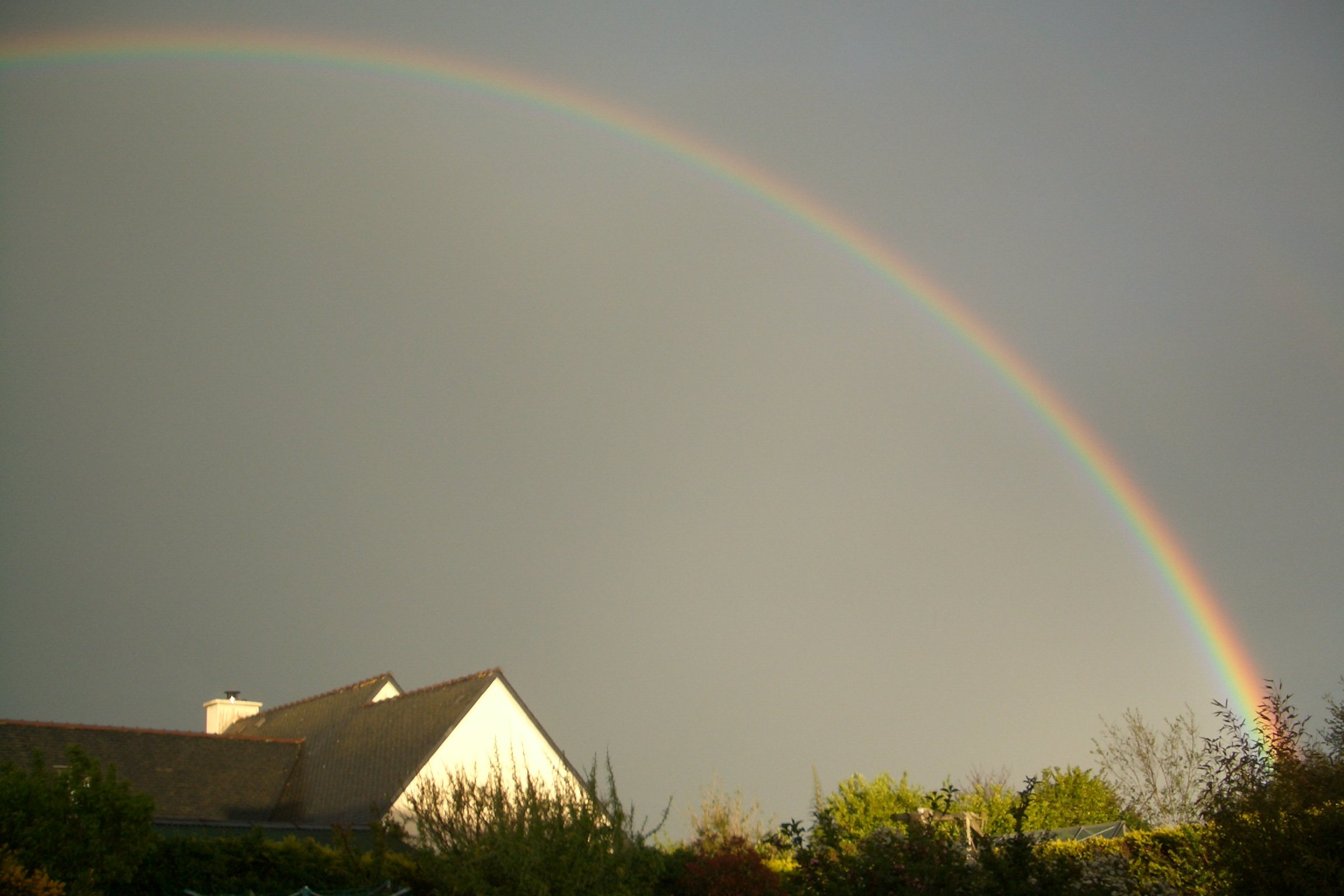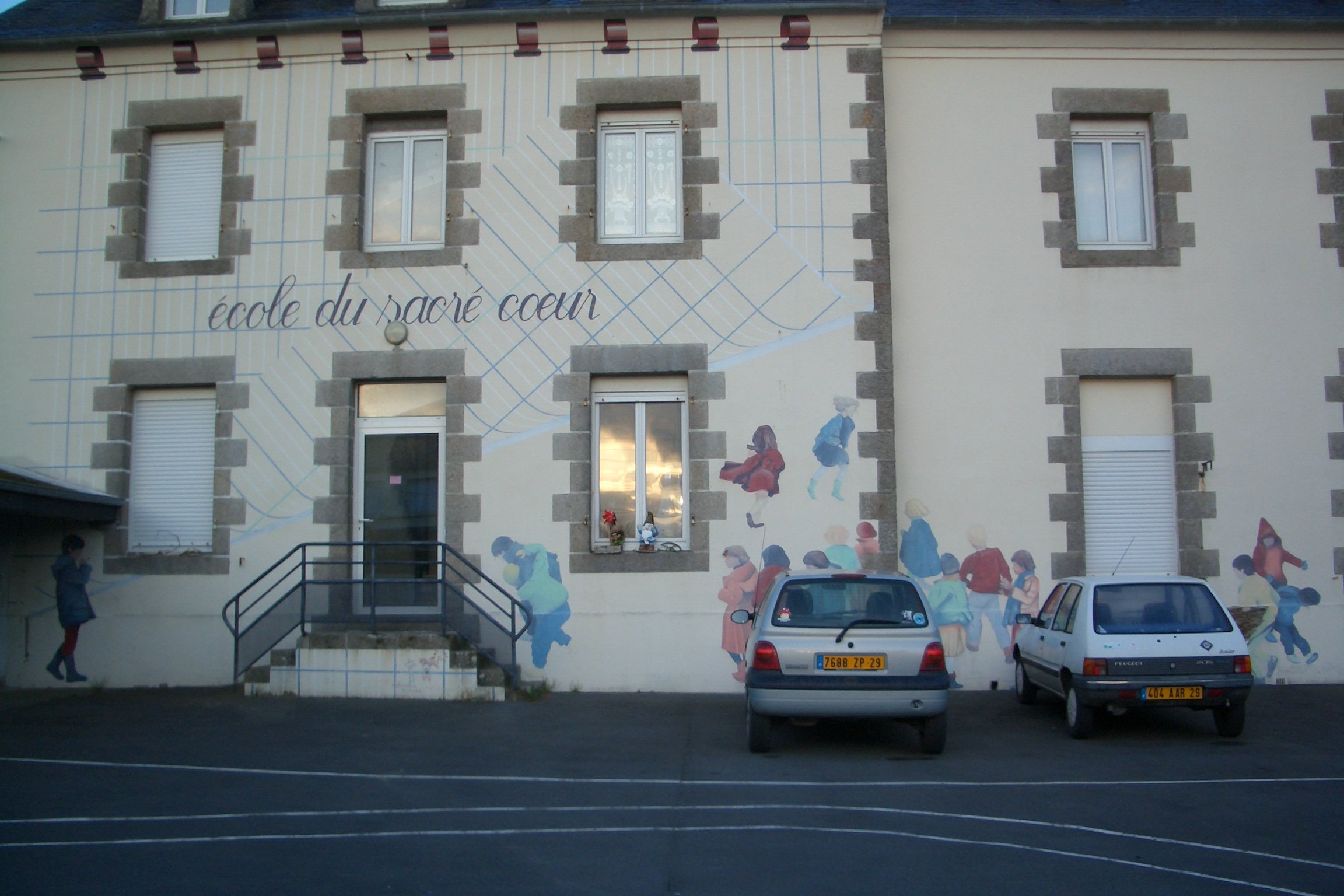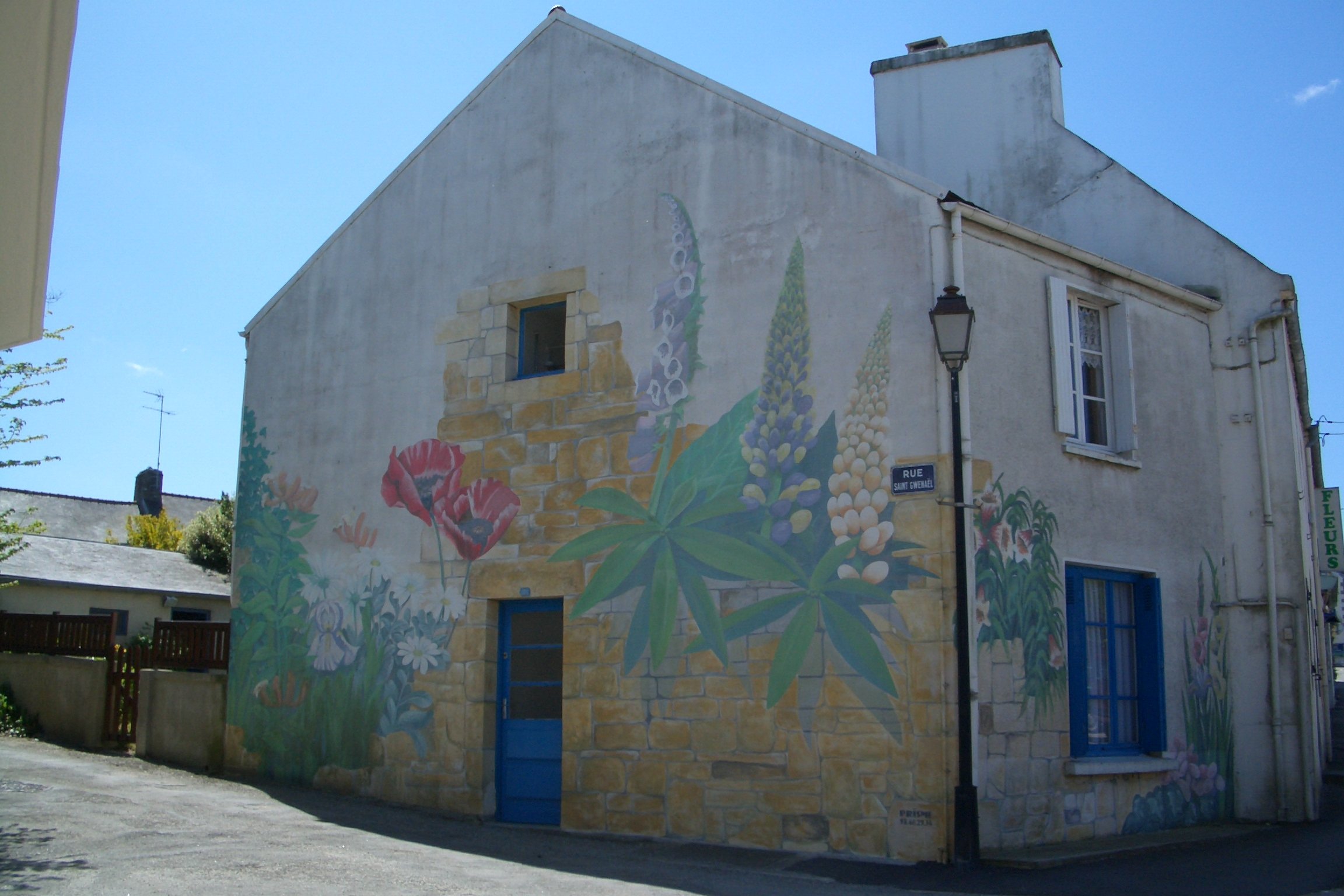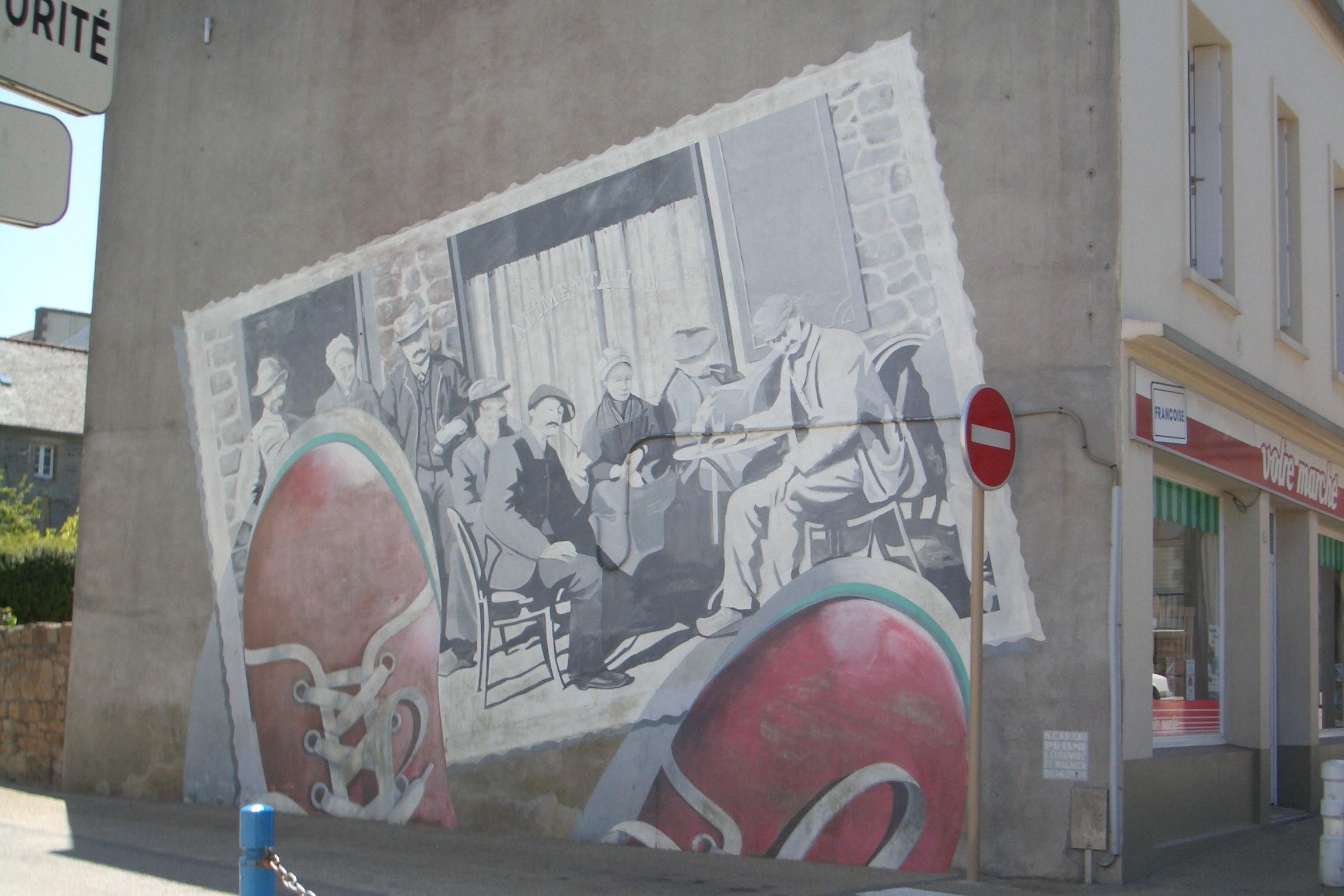Plougonvelin
posted 13 June 2005
 The towns around here are large in area and contiguous—that is, all of the counryside is officially within one town or another. Because the area is growing fairly rapidly in population, and because many tiny villages dotted the landscape before it was divided into officially incorporated towns, many towns (or "communes" as they are called here, meaning something more like "township" than anything to do with collectivism) include more than one "agglomeration." Plouzané has three—Trinité-Plouzané (mostly newly built since Ifremer brought 600 jobs to the area), Plouzané-Bourg (the original town, where the church is), and Locmaria-Plouzané (an older village that got incorporated into Plouzané at some point).
The towns around here are large in area and contiguous—that is, all of the counryside is officially within one town or another. Because the area is growing fairly rapidly in population, and because many tiny villages dotted the landscape before it was divided into officially incorporated towns, many towns (or "communes" as they are called here, meaning something more like "township" than anything to do with collectivism) include more than one "agglomeration." Plouzané has three—Trinité-Plouzané (mostly newly built since Ifremer brought 600 jobs to the area), Plouzané-Bourg (the original town, where the church is), and Locmaria-Plouzané (an older village that got incorporated into Plouzané at some point).
Plougonvelin (which greeted us with what has become our traditional arrival rainbow) has two agglomerations—Plougonvelin-Bourg, which includes the old church, the town hall, a cluster of businesses, the local supermarket, and our place, and the rest (which I think of as Plougonvelin Beach), which includes a couple of tourist hotels, an indoor seawater swimming pool/ water slide, and another cluster of businesses. We can't easily walk to the beach, but otherwise our part is better.
 We have a great bakery. Every morning (except Monday, its closing day), I stroll two long blocks along our lane (the "Route de Gorréquéar") out to the "main" street, pausing to pet the friendly yellow and white cat at number 9, checking out the busy colony of nesting sparrows in the cracks of an old stone barn, and looking to see what new things have come into bloom in the luxuriant vertical rock gardens that line the road. I turn right at the old Sacred Heart School (now vacant because they've just moved to a new location), where I look each morning to see whether the cars parked in its courtyard have moved so that I can get a decent picture of the mural (note, in addition to the many charming children, many more of whom are outside the frame, the comb binding at the top, under the eaves and the upward-curling page), then continue two blocks past the house favored by the local flock of swallows (its eves look just like all the others to me, but the swallows have a definite opinion), the church, the bar, two banks, and a defunct restaurant to buy our baguette and breakfast pastry. Just beyond the bakery are another bank, a butcher's shop, a little grocery store, a pub, a pharmacy, and the post office.
We have a great bakery. Every morning (except Monday, its closing day), I stroll two long blocks along our lane (the "Route de Gorréquéar") out to the "main" street, pausing to pet the friendly yellow and white cat at number 9, checking out the busy colony of nesting sparrows in the cracks of an old stone barn, and looking to see what new things have come into bloom in the luxuriant vertical rock gardens that line the road. I turn right at the old Sacred Heart School (now vacant because they've just moved to a new location), where I look each morning to see whether the cars parked in its courtyard have moved so that I can get a decent picture of the mural (note, in addition to the many charming children, many more of whom are outside the frame, the comb binding at the top, under the eaves and the upward-curling page), then continue two blocks past the house favored by the local flock of swallows (its eves look just like all the others to me, but the swallows have a definite opinion), the church, the bar, two banks, and a defunct restaurant to buy our baguette and breakfast pastry. Just beyond the bakery are another bank, a butcher's shop, a little grocery store, a pub, a pharmacy, and the post office.
 The Sacred Heart mural is only one of many. The first you see, over the top of the grocery story from a high spot on the road as you enter town, is of a huge postcard that reads "Mairie de Plougonvelin," which is in fact painted on the side of the Mairie (town hall/mayor's office). The giant flowers are on the side of a house near the bakery. The four "Healing Saints" grace an upstairs wall of the pharmacy, and the public library (across from the pub) has books all over it (of course). My favorite is the one on the side of the grocery store. It shows the toes of a pair of red sneakers holding down an antique black-and-white postcard of the grocery store as it appeared 100 years ago.
The Sacred Heart mural is only one of many. The first you see, over the top of the grocery story from a high spot on the road as you enter town, is of a huge postcard that reads "Mairie de Plougonvelin," which is in fact painted on the side of the Mairie (town hall/mayor's office). The giant flowers are on the side of a house near the bakery. The four "Healing Saints" grace an upstairs wall of the pharmacy, and the public library (across from the pub) has books all over it (of course). My favorite is the one on the side of the grocery store. It shows the toes of a pair of red sneakers holding down an antique black-and-white postcard of the grocery store as it appeared 100 years ago.


 The local wine shop is the Cave de Keruzas, and you'd never find it without the little cardboard hand-written signs that direct you there. We'd driven by and seen the sandwich sign out front, advertising local cork-finished hard cider and tastings of "chouchen," a local liqueur distilled from mead (honey wine; Brittany produces lots of honey), so one day we walked over to check it out. Aside from the signs, it looks just like somebody's house, and as we walked up the drive, we were a little dismayed at the group of people camped on the doorstep drinking—we almost turned back, but they had spotted us and cheerfully urged us to come in for a taste. Once again appearances were deceiving. The proprietor was charming and knowledgeable, and the inlaws not as alarming as they at first looked. David immediately got into a long wine discussion with the proprietor. When he made some remark about the small collection of excellent Scotch whiskies in one corner, the sister-in-law explained that the proprietor's wife was Scottish. I of course admitted to having a Scottish grandmother, so the Scottish wife was quickly fetched, and the locals got a big kick out of watching us speak English. It turns out she had come to Brest to work at Ifremer for a year (as part of a student exchange), studying scallops, but she married the wine merchant and settled down here to raise children rather than scallops. The brother in law even got to show off his English—as David and the proprietor were enthusing (in French) over Gros Plant as an accompaniment for oysters, he chimed in "Is wine of lobster also!"
The local wine shop is the Cave de Keruzas, and you'd never find it without the little cardboard hand-written signs that direct you there. We'd driven by and seen the sandwich sign out front, advertising local cork-finished hard cider and tastings of "chouchen," a local liqueur distilled from mead (honey wine; Brittany produces lots of honey), so one day we walked over to check it out. Aside from the signs, it looks just like somebody's house, and as we walked up the drive, we were a little dismayed at the group of people camped on the doorstep drinking—we almost turned back, but they had spotted us and cheerfully urged us to come in for a taste. Once again appearances were deceiving. The proprietor was charming and knowledgeable, and the inlaws not as alarming as they at first looked. David immediately got into a long wine discussion with the proprietor. When he made some remark about the small collection of excellent Scotch whiskies in one corner, the sister-in-law explained that the proprietor's wife was Scottish. I of course admitted to having a Scottish grandmother, so the Scottish wife was quickly fetched, and the locals got a big kick out of watching us speak English. It turns out she had come to Brest to work at Ifremer for a year (as part of a student exchange), studying scallops, but she married the wine merchant and settled down here to raise children rather than scallops. The brother in law even got to show off his English—as David and the proprietor were enthusing (in French) over Gros Plant as an accompaniment for oysters, he chimed in "Is wine of lobster also!"
previous entry List of Entries next entry
 The towns around here are large in area and contiguous—that is, all of the counryside is officially within one town or another. Because the area is growing fairly rapidly in population, and because many tiny villages dotted the landscape before it was divided into officially incorporated towns, many towns (or "communes" as they are called here, meaning something more like "township" than anything to do with collectivism) include more than one "agglomeration." Plouzané has three—Trinité-Plouzané (mostly newly built since Ifremer brought 600 jobs to the area), Plouzané-Bourg (the original town, where the church is), and Locmaria-Plouzané (an older village that got incorporated into Plouzané at some point).
The towns around here are large in area and contiguous—that is, all of the counryside is officially within one town or another. Because the area is growing fairly rapidly in population, and because many tiny villages dotted the landscape before it was divided into officially incorporated towns, many towns (or "communes" as they are called here, meaning something more like "township" than anything to do with collectivism) include more than one "agglomeration." Plouzané has three—Trinité-Plouzané (mostly newly built since Ifremer brought 600 jobs to the area), Plouzané-Bourg (the original town, where the church is), and Locmaria-Plouzané (an older village that got incorporated into Plouzané at some point).  We have a great bakery. Every morning (except Monday, its closing day), I stroll two long blocks along our lane (the "Route de Gorréquéar") out to the "main" street, pausing to pet the friendly yellow and white cat at number 9, checking out the busy colony of nesting sparrows in the cracks of an old stone barn, and looking to see what new things have come into bloom in the luxuriant vertical rock gardens that line the road. I turn right at the old Sacred Heart School (now vacant because they've just moved to a new location), where I look each morning to see whether the cars parked in its courtyard have moved so that I can get a decent picture of the mural (note, in addition to the many charming children, many more of whom are outside the frame, the comb binding at the top, under the eaves and the upward-curling page), then continue two blocks past the house favored by the local flock of swallows (its eves look just like all the others to me, but the swallows have a definite opinion), the church, the bar, two banks, and a defunct restaurant to buy our baguette and breakfast pastry. Just beyond the bakery are another bank, a butcher's shop, a little grocery store, a pub, a pharmacy, and the post office.
We have a great bakery. Every morning (except Monday, its closing day), I stroll two long blocks along our lane (the "Route de Gorréquéar") out to the "main" street, pausing to pet the friendly yellow and white cat at number 9, checking out the busy colony of nesting sparrows in the cracks of an old stone barn, and looking to see what new things have come into bloom in the luxuriant vertical rock gardens that line the road. I turn right at the old Sacred Heart School (now vacant because they've just moved to a new location), where I look each morning to see whether the cars parked in its courtyard have moved so that I can get a decent picture of the mural (note, in addition to the many charming children, many more of whom are outside the frame, the comb binding at the top, under the eaves and the upward-curling page), then continue two blocks past the house favored by the local flock of swallows (its eves look just like all the others to me, but the swallows have a definite opinion), the church, the bar, two banks, and a defunct restaurant to buy our baguette and breakfast pastry. Just beyond the bakery are another bank, a butcher's shop, a little grocery store, a pub, a pharmacy, and the post office. The Sacred Heart mural is only one of many. The first you see, over the top of the grocery story from a high spot on the road as you enter town, is of a huge postcard that reads "Mairie de Plougonvelin," which is in fact painted on the side of the Mairie (town hall/mayor's office). The giant flowers are on the side of a house near the bakery. The four "Healing Saints" grace an upstairs wall of the pharmacy, and the public library (across from the pub) has books all over it (of course). My favorite is the one on the side of the grocery store. It shows the toes of a pair of red sneakers holding down an antique black-and-white postcard of the grocery store as it appeared 100 years ago.
The Sacred Heart mural is only one of many. The first you see, over the top of the grocery story from a high spot on the road as you enter town, is of a huge postcard that reads "Mairie de Plougonvelin," which is in fact painted on the side of the Mairie (town hall/mayor's office). The giant flowers are on the side of a house near the bakery. The four "Healing Saints" grace an upstairs wall of the pharmacy, and the public library (across from the pub) has books all over it (of course). My favorite is the one on the side of the grocery store. It shows the toes of a pair of red sneakers holding down an antique black-and-white postcard of the grocery store as it appeared 100 years ago.

 The local wine shop is the Cave de Keruzas, and you'd never find it without the little cardboard hand-written signs that direct you there. We'd driven by and seen the sandwich sign out front, advertising local cork-finished hard cider and tastings of "chouchen," a local liqueur distilled from mead (honey wine; Brittany produces lots of honey), so one day we walked over to check it out. Aside from the signs, it looks just like somebody's house, and as we walked up the drive, we were a little dismayed at the group of people camped on the doorstep drinking—we almost turned back, but they had spotted us and cheerfully urged us to come in for a taste. Once again appearances were deceiving. The proprietor was charming and knowledgeable, and the inlaws not as alarming as they at first looked. David immediately got into a long wine discussion with the proprietor. When he made some remark about the small collection of excellent Scotch whiskies in one corner, the sister-in-law explained that the proprietor's wife was Scottish. I of course admitted to having a Scottish grandmother, so the Scottish wife was quickly fetched, and the locals got a big kick out of watching us speak English. It turns out she had come to Brest to work at Ifremer for a year (as part of a student exchange), studying scallops, but she married the wine merchant and settled down here to raise children rather than scallops. The brother in law even got to show off his English—as David and the proprietor were enthusing (in French) over Gros Plant as an accompaniment for oysters, he chimed in "Is wine of lobster also!"
The local wine shop is the Cave de Keruzas, and you'd never find it without the little cardboard hand-written signs that direct you there. We'd driven by and seen the sandwich sign out front, advertising local cork-finished hard cider and tastings of "chouchen," a local liqueur distilled from mead (honey wine; Brittany produces lots of honey), so one day we walked over to check it out. Aside from the signs, it looks just like somebody's house, and as we walked up the drive, we were a little dismayed at the group of people camped on the doorstep drinking—we almost turned back, but they had spotted us and cheerfully urged us to come in for a taste. Once again appearances were deceiving. The proprietor was charming and knowledgeable, and the inlaws not as alarming as they at first looked. David immediately got into a long wine discussion with the proprietor. When he made some remark about the small collection of excellent Scotch whiskies in one corner, the sister-in-law explained that the proprietor's wife was Scottish. I of course admitted to having a Scottish grandmother, so the Scottish wife was quickly fetched, and the locals got a big kick out of watching us speak English. It turns out she had come to Brest to work at Ifremer for a year (as part of a student exchange), studying scallops, but she married the wine merchant and settled down here to raise children rather than scallops. The brother in law even got to show off his English—as David and the proprietor were enthusing (in French) over Gros Plant as an accompaniment for oysters, he chimed in "Is wine of lobster also!"